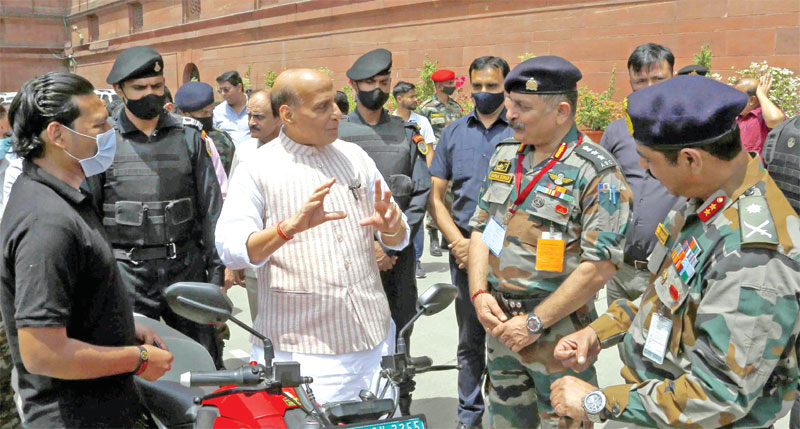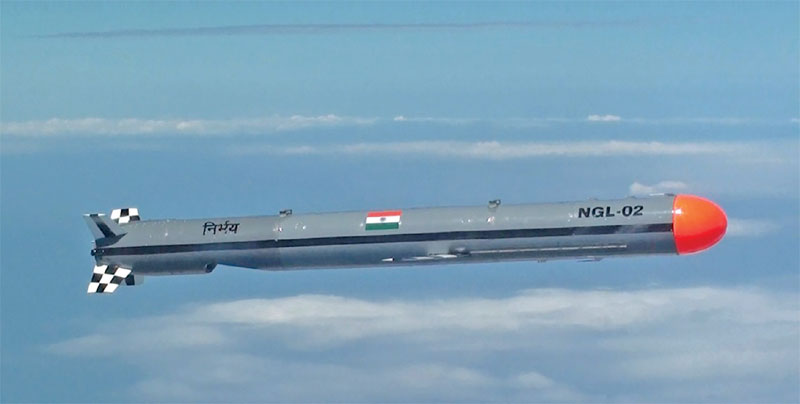Faulty policies and systemic problems come in the way of self-reliance in defence
 Cdr S. Shrikumar (retd)
Cdr S. Shrikumar (retd)
In a bold move amending the Defence Acquisition Procedure-2020 (DAP-2020), government in end April 2022, announced that ‘going forward, all modernisation requirements of the defence services and the Indian Coast Guard are to be indigenously sourced irrespective of the nature of the procurement.’
Other enabling amendments to the extant rules, related to earnest money deposit (EMD) and performance bank guarantee (PBG), are also being introduced. Collectively, the amendments are intended to accelerate ‘Make in India’ and enhance the ‘ease’ of doing business in India—especially for the domestic manufacture of defence equipment.
The abrupt departure from what has hitherto been a policy of incremental change is ambitious. Incremental change through various measures such as enhanced limits for FDI in the defence sector, Make-I/II schemes, strategic partnerships, defence offsets etc. have not delivered the hoped-for impact in ending India’s reliance on imports for its defence needs.
Admittedly, India is unprepared to deal with the fallout of the latest changes in its policies for defence acquisition. These changes place an onerous responsibility on the DRDO, the DPSUs, the Ordnance Factories and the private defence industry to meet the modernisation requirements of the armed forces. However, equally, this is also a moment of significant opportunity for the various actors in the Indian defence ecosystem.
In the long-term, self-reliance in defence can only be attained through the acquisition of indigenous capability in Design & Development (D&D) & manufacture of defence equipment. This requires a multi-fold increase in investment in defence R&D (both, the government and the private sector), increasing researcher density, shifting the focus from applied research to basic research, and most importantly, creating a broader defence manufacturing eco-system with the public/ private sector defence firms and the MSMEs. No nation has ever achieved self-reliance in defence without sustained investments in indigenous R&D capability.

The two World Wars and the years leading up to the wars spurred the frenetic development of several technologies in Europe, the USA and Japan. The technologies, systems, platforms and strategies developed in response to the wars, fundamentally altered how wars were fought and finally won.
Israel’s geographical location, amidst hostile neighbours, drives and sustains its self-reliance. South Korea’s experience in the Korean war spurred the growth of its defence industry.
During the war with China in 1962, India was a young republic, just beginning to find its feet as an independent nation. The defeat in 1962, exposed India’s vulnerabilities and aroused defence consciousness after years of neglect. Several defence reforms have been undertaken since then, but they were largely piecemeal and ad-hoc and failed to address the root causes that continue to hold back the growth of the Indian defence industry.
The present moment of global geopolitical ferment and a radical domestic policy shift on defence equipment sourcing, is an apt moment to reflect on and take stock of the various attempts at policy reform and their success/ failure in impacting India’s self-reliance in defence.
Supply Diversification
Russia launched its invasion/ special military operation in Ukraine on 24 February 2022. Predictably, the west, led by the US, imposed a slew of diplomatic and economic sanctions aimed at isolating Russia and crippling its economy.
Ever since the conflict began, India has abstained from voting on different UN resolutions on the conflict, including the resolution moved in early March 2022 to censure Russia for its decision to initiate aggressive action against Ukraine.
Liz Truss, UK’s foreign secretary while speaking to the UK’s foreign affairs committee commented that India’s position in the UN on the Russia-Ukraine conflict was chiefly driven by India’s dependence on Russia for its defence needs. The accuracy of this assessment cannot be denied, since over 50 per cent of India’s defence equipment is of Russian origin.
India’s historical reliance on Russian equipment has several reasons. The cost competitiveness of Russian equipment, Russia’s greater willingness to share military technology, and the proven battlefield performance of its equipment are the chief drivers of the Russia-tilt in India’s military arsenal.

However, lately, over the past decade, there has been a conscious effort, in India, to diversify its military arsenal. In pursuance of this diversification strategy, a majority of India’s recent purchases of aircraft, helicopters, and submarines have been from the United States and France.
However, equipment procurement from multiple countries comes with its own unique set of challenges—problems of interoperability between equipment, restrictions on cross-deployment of personnel, the requirement of separate facilities for training, repair & overhaul, higher equipment/ spares procurement costs due to lower efficiencies of scale etc. The Indian armed forces have grappled with these problems in past procurements.
Further, seen from a strategic viewpoint, switching from a dependency on Russia to a dependency on the west is not a solution to the problem of dependence on imports for defence needs.
The SQRs Debate
The Kargil war officially came to an end on 26 July 1999. The Kargil Review Committee was set up on 29 July 1999 to ‘examine the sequence of events and make recommendations for the future.’ The committee submitted its report on 15 December 1999.
Among its many observations, the report highlighted that India was lagging in the quality of its surveillance and communication equipment. The same was true for much of the other equipment across all three services.
Ever since, every assessment of self-reliance in defence has highlighted the slow progress of indigenisation over the past two decades leading to continued reliance on imports for defence needs. The DRDO is responsible for the indigenisation and upgradation of equipment for India’s defence services. For India, the challenge has always been to strike a balance between ‘make and buy’.
A frequent observation made by the DRDO is that the defence services draw up staff qualitative requirements (SQRs) for the equipment that they need, by picking the best features of equipment available from manufacturers from around the world. This observation is not without basis. At the same time, it is difficult to fault the services for wanting the best of what is available from global defence suppliers.
Even within the services, there is disagreement over the method of drafting SQRs. India’s first CDS, the late Gen. Bipin Rawat, speaking to the Times of India in May 2020 had said that ‘We are not expeditionary forces that have to deploy around the globe. We have to guard and fight only along our borders and, of course, dominate the Indian Ocean region. So, we should not go in for large amounts of imports by misrepresenting our operational requirements.’

According to him, ‘unrealistic SQRs’ prepared by the services push the country towards importing equipment. He opined that instead, “We should define SQRs as per our own operational requirements, and not look at what the US or other advanced countries have.” Gen. Rawat was of the view that the services should support indigenisation efforts by, initially, accepting equipment even if they meet only 70 per cent of the SQRs. With time, he argued, indigenous equipment would match the state-of-art equipment available elsewhere.
The recent withdrawal of four of the five bidders, initially in the fray for the contract to build P-75(India) submarines, could be adduced as being illustrative of the issue of unrealistic SQRs. The proposed P-75(India) contract envisages the construction in India, under the strategic partnership model, of six conventional submarines with AIP capability. The four bidders that have withdrawn from the race are all leading shipbuilders with an established track record in submarine construction. One other potential bidder (SAAB, Sweden) had withdrawn from the race at the RFI stage itself citing similar reasons. This disagreement over the SQRs drawn up by the defence services and what the DRDO/ industry views as ‘unrealistic’ has in itself been a major factor slowing down the pace of indigenisation.
FDI in the Defence Sector
In early 2020, Indian and Chinese troops engaged each other in aggressive run-ins along the Line of Actual Control (LAC) in eastern Ladakh. The simmering tensions came to a boil in mid-June 2020, leading to actual fighting and casualties on both sides.
Currently, an uneasy calm prevails as diplomatic parleys between the two sides attempt to find ways to end disagreements peacefully. Following the crisis, the government made two key policy announcements to strengthen military preparedness. In its first announcement, in mid-May 2020, the government enhanced the cap on Foreign Direct Investment (FDI) in the defence sector from 49 per cent to 74 per cent under the automatic route for certain niche technologies. Additionally, the new policy provided for FDI even up to 100 per cent, with government approval.
FDI in defence was first permitted in 2001. However, in the period since 2001, the expectations of attracting large scale FDI in defence have been belied. Very little FDI has been channelled by foreign defence companies for defence manufacturing through joint ventures with Indian defence firms.
The reasons for the low FDI inflow are well known and are largely due to:
- Apprehensions around guaranteed and sustained support to make the investments/ JVs financially viable.
- The onerous and somewhat ambiguous policy provisions.
- Fear of award of contracts by the government through nomination to the DPSUs/ Ordnance Factories owing to political compulsions.
The government, in its second announcement in late July 2020, granted ‘special powers to the three services for individual capital procurement programmes of Rs 300 crore to meet emergent operational requirements.’ Following the grant of the special powers, the armed forces inked contracts for the procurement of equipment to meet their immediate requirements.
The rush, in response to the border crisis, to order equipment from foreign armament suppliers, once again, exposed India’s vulnerability with regard to its dependence on imports for defence needs. Similar emergency procurements were undertaken in 1999, during the Kargil conflict. Clearly, not much has changed since then.
Defence Offsets
Another mechanism for India to achieve self-reliance in defence is ‘Offsets’. In traditional procurement, goods or services are exchanged for money. Defence procurement is different. Countries buying arms stipulate that some form of work should directly flow back to them from the contracts that they sign with foreign arms sellers. This flow back arrangement is commonly known as ‘offsets’. Offsets are usually stipulated at a fixed percentage of the contract value.

India’s defence offset policy, first published in 2005, has been revised multiple times in an attempt to progressively make it more effective. However, has the Indian offset policy, now over a decade and a half old, been successful in either bringing in FDI or attracting high-end manufacturing/ technology into the local industry?
An honest appraisal would suggest that the policy has worked to only serve the limited purpose of promoting exports of civilian aerospace parts and components. Some of the reasons for the ineffectiveness of the offsets policy are:
- Policy inadequacies when compared to international offset best practices.
- Extremely moderate thresholds & percentages for offsets (India: contract value USD285 million/ offset value 30 per cent; Malaysia: contract value USD15 million/ offset value 100 per cent; South Korea: contract value USD10 million / offset value 50 per cent; UAE: contract value USD10 million/offset value 60 per cent etc.).
- Non-insistence on the principle of local value addition in both manufacturing and service offset contracts.
- Non-application of the principle of additionality & causality.
- Total freedom to the foreign vendors to choose areas of offsets.
- Lax monitoring of offset contract adherence and progress.
Jurgen Brauer and John Paul Dunne in their book, Arms Trade and Economic Development: Theory, Policy, and Cases in Arms Trade Offsets, widely acknowledged as the most comprehensive study of offsets, state that, ‘neither economic theory nor extant empirical evidence suggests that offset arrangements yield net benefits.’
In a different book, they strongly argue that ‘offsets do not result in arms acquisition cost reductions, offsets do not stimulate broad-based civilian economic development, neither substantial nor sustained job creation occurs, not even within the military sector, that almost no successful technology transfer into the civilian sector is observed, and that only limited technology transfer into the military sector occurs, often over decades and at a high cost. Moreover, whatever technology is transferred is quickly outpaced by continuous technology advances in the main developed countries.’
A crucial issue, overlooked in all the hype around offsets for developing indigenous capability, is that offsets inflate the cost of the main procurement contracts. It is believed that the administrative cost of offsets alone amounts to seven to 10 per cent of the contract value.
Neither greater FDI in defence nor offsets is likely to help India overcome its reliance on imports. However, for the short-term, attracting FDI or entering offset arrangements with global arms majors for technology transfers/ joint development projects/ licensed production arrangements etc. is inescapable—to quickly bridge the existing technology divide.
Negative Lists
The government of India, in August 2020, announced the first ‘negative list’ of defence equipment. The government stipulated that the 101 equipment on the ‘negative list’, could no longer be imported and would, henceforth, need to be procured only from domestic manufacturers—private sector defence firms and the Defence Public Sector Undertaking (DPSUs).
This was followed, in May 2021 and April 2022, by the second and third negative lists of 108 and 101 items respectively. The embargo on the import of equipment does not come into effect immediately but is staggered over the next few years. This policy of negative lists is an adjunct to the earlier policy initiatives rolled out over the past several years by the government. Collectively, the policies aim to accelerate India’s objective of attaining self-reliance in defence needs. While the policy announcements have succeeded in creating an air of expectation and optimism in the DPSUs and the private sector defence firms, no significant headway has been made on the ground by way of an award of any breakthrough contract(s).
A follow-on press release to the August 2020 negative list announcement added that for a product to be considered as an indigenous system, the percentage of indigenous content (IC) has to meet the minimum laid down specifications. This implies that equipment on the negative list must be designed and developed by the DRDO/ Indian defence firms and must meet the specified stipulation on indigenous content (50 per cent indigenous content as per DAP-2020). This effectively means that items on the negative lists can only be procured under the Buy (IDDM) category.

This renders the other procurement categories, ‘Buy (Indian)’, ‘Buy and Make (Indian)’, ‘Buy (Global-Manufacture in India)’ and ‘Buy (Global)’ redundant—since all these categories allow the procurement of equipment designed and developed by foreign OEMs.
While the negative lists were promulgated, it was also highlighted that the lists were promulgated ‘after several rounds of consultations with all stakeholders, including Army, Air Force, Navy, DRDO, Defence Public Sector Undertakings (DPSUs), Ordnance Factory Board (OFB) and (the) private industry to assess current and future capabilities of the Indian industry for manufacturing various ammunition/ weapons/ platforms/ equipment in India.’
This signifies that indigenously designed, developed, and manufactured versions of the items (with IC of 50 per cent) would be available by the date that the embargo comes into effect. Judging by the nature of many of the items (APFSDS, INS for ship applications, conventional submarines, UUVs, buoyancy gliders, etc., to name a few) on the negative lists this seems rather unlikely.
Non-availability of an equivalent indigenous item before the embargo on the item comes into effect, will throw up a particularly prickly problem. If the item is operationally critical, the MoD will be left with no option but to waive the restriction against import/ indigenous content stipulated by the negative list rule. No procedure has yet been specified for seeking/ approving such waivers. The need to seek/ approve waivers in itself would introduce avoidable delays in the already lengthy procurement process.
However, a definite benefit to the defence industry from the promulgation of the negative lists is that the industry gains a clear understanding of the equipment requirements of the armed forces. The lists assure the industry that if they develop the items on the list, they have a reasonable chance of a future sale as long as the developed item meets the indigenous content stipulation and matches the capabilities of contemporary systems available elsewhere. The negative lists also help firms with their planning to help pick the item that best aligns with their capabilities and potentially provides the best business returns.
While the domestic firms gain from the negative lists, foreign firms too can look forward to significant continued business. The policy stipulates Indian design and 50 per cent indigenous content by value. No defence manufacturer can be self-sufficient in all aspects of equipment development and manufacture. Foreign firms will continue to play a role through the supply of components and technology (potentially up to 50 per cent of the equipment’s value).
Looking Ahead
Self-reliance in defence is a decades-long project—requiring significant upfront investment in the near to medium term. Also, after the DPSUs/ private sector firms and the MSMEs have developed critical technologies, they will then need to work on securing an export market to bring in economies of scale for the business to be financially viable. This is what nations such as the US, Russia, the UK, France, China, Israel, and Germany, have done.
In 2022, India, now the fifth largest economy in the world, can no longer continue being dependent on imports for 70 per cent of its defence needs. The current global geopolitical churn and the tensions on its borders with China could be the moment that spurs India to initiate a planned, determined and sustained push to acquire capabilities in indigenous D&D and defence manufacturing. India cannot continue to nurse ambitions of being a global economic, technological, and military power and yet, remain dependent on imports for its defence needs.

